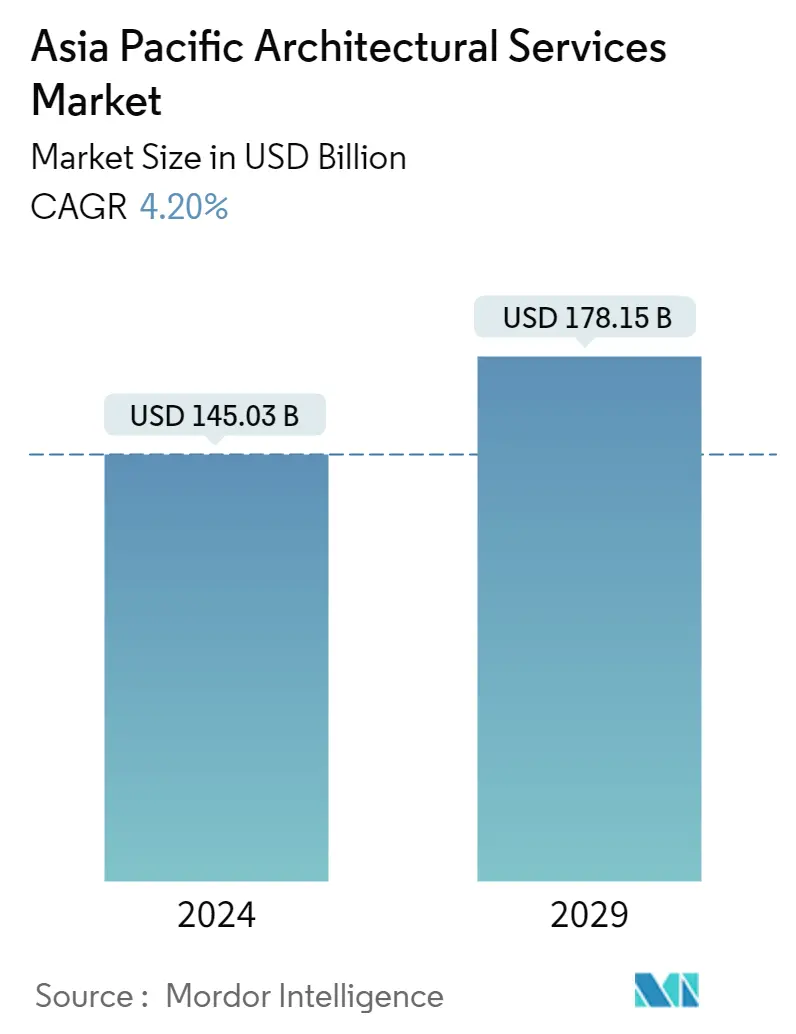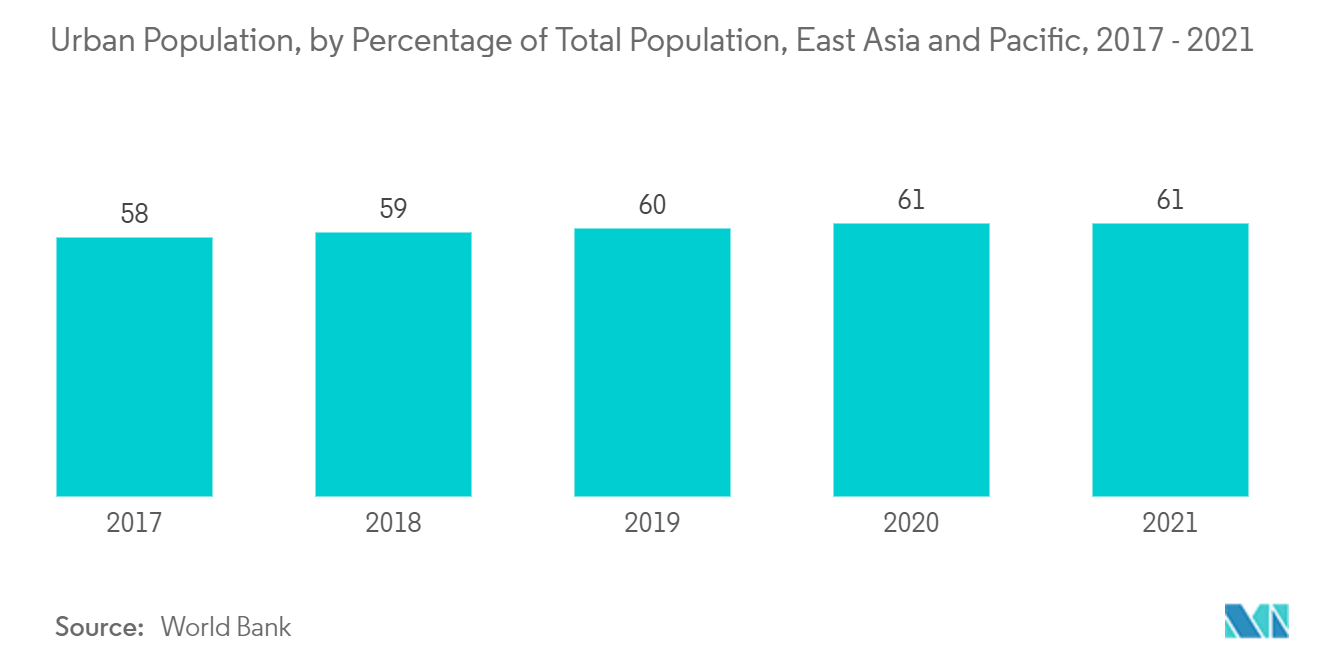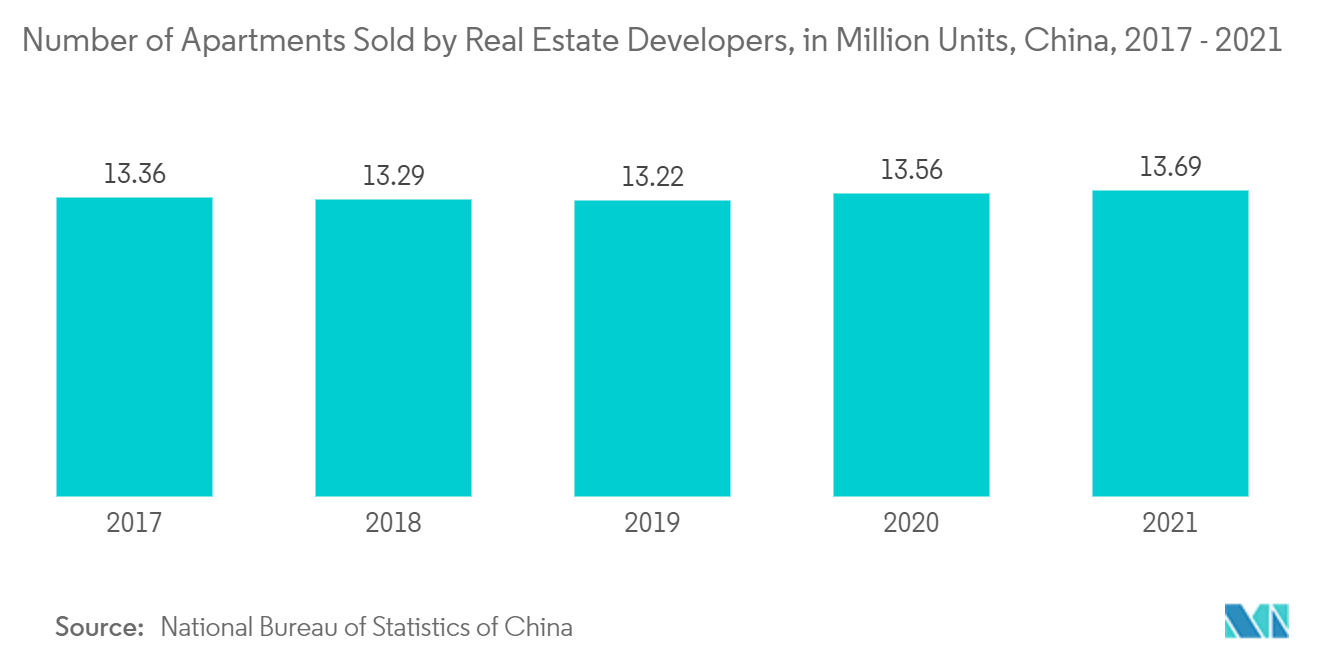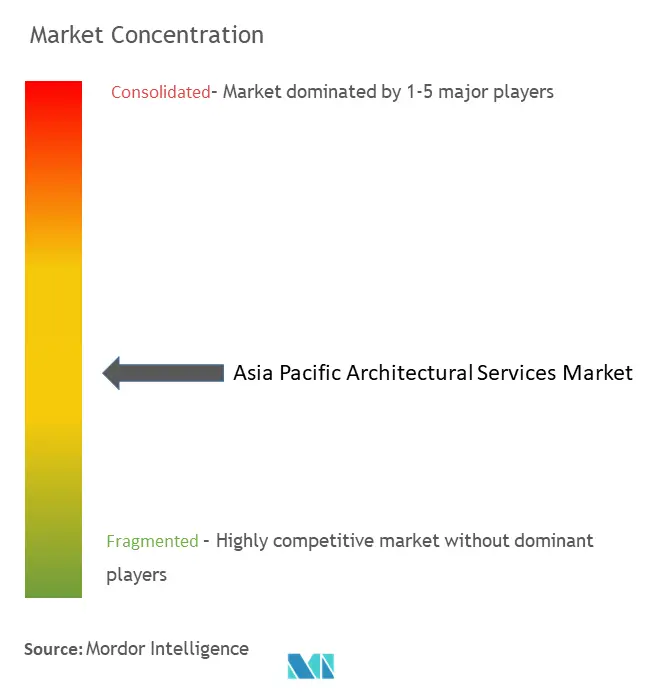Asia Pacific Architectural Services Market Size

| Study Period | 2019 - 2029 |
| Base Year For Estimation | 2023 |
| Market Size (2024) | USD 145.03 Billion |
| Market Size (2029) | USD 178.15 Billion |
| CAGR (2024 - 2029) | 4.20 % |
| Market Concentration | Medium |
Major Players
*Disclaimer: Major Players sorted in no particular order |
Asia Pacific Architectural Services Market Analysis
The Asia Pacific Architectural Services Market size is estimated at USD 145.03 billion in 2024, and is expected to reach USD 178.15 billion by 2029, growing at a CAGR of 4.20% during the forecast period (2024-2029).
Rapid urbanization, increasing demand for smart homes, and rising commercial and industrial building infrastructural upgradation activities across the globe are among the significant factors driving market growth.
- Architectural planning witnessed a paradigm shift in the last few years due to computer software's emergence. Advancements in digital design tools, computer-controlled fabrication, computer-controlled connectedness, and interconnectedness have enabled a new phase of the designing and building processes.
- Architectural services comprise a wide variety of processes, including feasibility studies, architectural programming, project management with the help of design, preparation of construction documents, and construction administration. The increasing demand for green buildings drives the architectural services market, as sustainable construction provides essential benefits and business opportunities. Moreover, the return on investment can be improved, along with the occupancy, thereby saving operating costs.
- The Asia Pacific region is characterized by significant ongoing and upcoming infrastructural projects, particularly smart city projects, across Singapore, China, Japan, and India, which may create a demand for architectural services. According to the India Brand Equity Foundation (IBEF), the real estate sector in India is expected to reach a value of USD 1 trillion by 2030, which may account for over 13% of the country's GDP by 2025.
- In the context of technology insertion, homes are adopting automation and transforming it into smart homes. New buildings are designed by keeping automation as the top priority. Automated systems aid in functions like security, temperature control, and lighting, which help control bills and positively impact the environment and the surroundings.
- Furthermore, the architectural industry in the Asia Pacific region is growing considerably, with an increasing number of new architectural firms entering the market with innovative designs and software, thereby providing better services, such as enhancements in urban planning. These advancements are expected to increase the demand for upgraded design technology involving 3D models and high-end designing software. The entry of new players is backed by several investments from venture capital firms, which supports the growth of the studied market.
- However, low awareness compared to the developed regions, along with higher costs involved and a shortage of qualified individuals with design and execution expertise, are among the most significant impediments to the growth of the studied market in the Asia Pacific region.
- The COVID-19 pandemic negatively impacted firms offering architectural services, especially during the initial phase. The widespread lockdown imposed across various countries significantly reduced construction activities, bringing a slowdown in demand for architectural services. However, the market regained momentum as the condition improved and moved towards normalcy due to the widespread vaccination in the region. It is expected to follow a similar pattern during the forecast period.
Asia Pacific Architectural Services Market Trends
This section covers the major market trends shaping the APAC Architectural Services Market according to our research experts:
Residential Sector to Hold Significant Market Share
- The residential sector is among the largest end-user segments for architectural services. The residential project stakeholders use different forms of architectural visualization to serve distinct needs. These architectural services provide various help, including interior design, in the residential sector to ensure a successful residential construction project. The operating firms work with trusted partners, suppliers, and service providers to help users achieve their project goals.
- Rapid urbanization significantly boosts the Asia-Pacific region's residential architectural services market. In the Asia Pacific region, the urbanization rate is considerably higher in the East Asia and Pacific region, as about 61% of the population stays in urban areas. In South Asia, this number accounts for only 35%. (Source: World Bank). However, this rate is expected to increase with the growth of the industrial sector and will contribute significantly to the demand for housing, in turn, the studied market.
- Furthermore, the growing urban population is driving the government to take several initiatives to ensure the sufficient availability of residential spaces. For instance, the Indian government recently introduced the Affordable Rental Housing Scheme (AHRC) to provide migrant workers with affordable rental housing. This, combined with the Maharashtra Chief Minister's introduction of the Maha Awas Yojana, a new rural housing project, is projected to propel India's residential construction sector forward.
- Similarly, in Malaysia's 2021 budget, the government proposed several incentives to increase homeownership. For example, the Malaysian government declared that first-time property buyers in the country will be exempt from paying stamp duty until 2025. Several Malaysians who want to buy a home in the nation will profit from the stamp duty exemption.
- In November 2022, Thailand's Government Housing Bank (GHB) sought approval from the cabinet and Finance Ministry for the third phase of the "One Million Home" project, which aims to provide housing to low income-earners. Initiatives such as these are expected to create many opportunities for architectural services in the residential arena.

China to Hold Significant Market Share
- China's urbanization rate is among the highest in the Asia-Pacific region. According to the National Bureau of Statistics (NBS) of China, the degree of urbanization in China has increased from 61.5% in 2018 to 64.72% in 2021. The country plans to take the urbanization rate beyond 65% by 2025.
- Rapid industrialization is among the significant factors driving the country's urban population count, as many workforces are required in industries. To support the urbanization growth, the government is taking several initiatives, such as investing in new residential and commercial spaces to ensure accommodation for inhabitants.
- For instance, according to the data from the American Institute of Architects (AIA) Shanghai reports, by 2025, China will have constructed the equivalent of 10 New York-sized cities since the 1990s. Furthermore, according to the NBS of China, in 2021, about 13.69 million units of apartments were sold by real estate developers in China.
- China remains a site for architectural experimentation and attracts multiple companies to provide architectural services. Although, in the past development of China's construction industry, architectural design only profoundly participated in the subsequent building construction process after submitting design drawings, showing a state of fragmentation between architectural design and building construction, which has brought a series of drawbacks. The shortcomings of the traditional production model have promoted the development of new business models, such as general engineering contracting and whole-process engineering consulting, which are supporting the growth of the studied market.
- Furthermore, China has registered rapid development of Leadership in Energy and Environmental Design (LEED) green buildings over the past few years, with first-tier cities remaining the most active players. As of April 2021, nearly 6,600 projects in China totaling more than 330 million square meters either received the Leadership in Energy and Environmental Design (LEED) certification or were working toward it, making it the second-largest market after the United States in terms of LEED certification, according to data by the US Green Building Council.
- China is also massively investing in the digital transformation of its cities and has developed smart city infrastructure that has already been applied to many of its major metropolises and their industries. Furthermore, China's state-led initiatives in technological innovation and public-private enterprise involvement are further expected to drive the demand for architectural services during the forecast period.

Asia Pacific Architectural Services Industry Overview
The Asia Pacific architectural services market is moderately competitive and is growing in competition with the entry of an increased number of players. The market consists of a significant number of local and global players. The players focus on expanding their client base across the region and adopting organic and inorganic growth strategies. Some major players operating in the market include IBI Group Inc., AECOM Ltd., Aedas Architects Ltd, and HDR Architecture Inc., among others.
In December 2022, Zaha Hadid Architects and Architects 61 unveiled the design for the new Science Center in Jurong Lake District, Singapore. The 52,460 square meters complex aims to make science, technology, engineering, and mathematics (STEM) more accessible through educational programs, specialized amenities, and interactive experiences. According to the company, the building is expected to open in 2027.
In November 2022, the Department of Architecture, under the National University of Singapore College of Design and Engineering (NUS CDE), opened the new Architectural Conservation Laboratory (ArClab). It is a unique living laboratory housed in a conserved building. It will serve as a site for researchers, built heritage professionals, and graduate students to conduct a wide range of teaching and research activities on sustainable development of the built environment.
Asia Pacific Architectural Services Market Leaders
-
IBI Group Inc.
-
Aedas Architects Ltd
-
AECOM Ltd.
-
HDR Architecture Inc.
-
Arup Group Limited
*Disclaimer: Major Players sorted in no particular order

Asia Pacific Architectural Services Market News
- August 2022: Dewan Architects + Engineers, a multidisciplinary architectural design firm, opened its first office in Vietnam to support its growth and expand its footprint in Southeast Asia. Located in the Bitexco Financial Tower in Ho Chi Minh City, the office will be staffed by the company's growing team of engineers and architects.
- March 202: British architecture practice Foster + Partners unveiled its masterplan design for a new 117.4-hectare city in Ho Chi Minh City, Vietnam, including residential neighborhoods, medical, education, and medical and leisure facilities. Foster + Partners was selected by developers Masterise Homes to design the masterplan for the city, which will feature high- and low-rise apartments, villas, social housing, and education facilities, as well as a large shopping mall and medical and administration facilities.
Asia Pacific Architectural Services Market Report - Table of Contents
1. INTRODUCTION
- 1.1 Study Assumptions and Market Definition
- 1.2 Scope of the Study
2. RESEARCH METHODOLOGY
3. EXECUTIVE SUMMARY
4. MARKET INSIGHTS
- 4.1 Market Overview
- 4.2 Industry Value Chain Analysis
-
4.3 Industry Attractiveness - Porter's Five Forces Analysis
- 4.3.1 Bargaining Power of Suppliers
- 4.3.2 Bargaining Power of Buyers
- 4.3.3 Threat of New Entrants
- 4.3.4 Threat of Substitute Products
- 4.3.5 Intensity of Competitive Rivalry
- 4.4 Impact of COVID-19 on the Market
5. MARKET DYNAMICS
-
5.1 Market Drivers
- 5.1.1 Increasing Demand for Green Building
- 5.1.2 Adoption of 3D Printing
-
5.2 Market Restraints
- 5.2.1 Lack of New Skills and Knowledge in Designing
- 5.3 Key Construction Hotspots in Asia-Pacific
6. MARKET SEGMENTATION
-
6.1 By End-user Vertical
- 6.1.1 Residential
- 6.1.2 Education
- 6.1.3 Healthcare and Life Sciences
- 6.1.4 Corporate
- 6.1.5 Other End-user Verticals
-
6.2 By Country
- 6.2.1 China
- 6.2.2 India
- 6.2.3 Japan
- 6.2.4 Singapore
- 6.2.5 Hong Kong
- 6.2.6 Rest of Asia Pacific
7. COMPETITIVE LANDSCAPE
-
7.1 Company Profiles
- 7.1.1 IBI Group Inc.
- 7.1.2 Aedas Architects Ltd
- 7.1.3 AECOM LTD.
- 7.1.4 HDR Architecture Inc.
- 7.1.5 M. Arthur Gensler Jr. & Associates Inc.
- 7.1.6 HKS Inc.
- 7.1.7 Stantec Inc.
- 7.1.8 CallisonRTKL Inc.
- 7.1.9 Skidmore, Owings & Merrill LLP
- 7.1.10 DP Architects Pte. Ltd.
- 7.1.11 B+H ARCHITECTS (SINGAPORE) Pte Ltd
- 7.1.12 MORPHOGENESIS Realty Pvt. Ltd
- 7.1.13 WSP Architects
- 7.1.14 Safdie Architects LLC
- 7.1.15 Aamer Architects
- 7.1.16 Arup Group Limited
- 7.1.17 Mitsubishi Jisho Sekkei
- 7.1.18 KUME SEKKEI Co. Ltd
- *List Not Exhaustive
8. INVESTMENT ANALYSIS
9. FUTURE OF THE MARKET
** Subject To AvailablityAsia Pacific Architectural Services Industry Segmentation
Architectural services include two interrelated but distinct endeavors: the planning and design of buildings and spaces and the administration of construction contracts on behalf of clients. The rising number of new homes sold in several countries across the Asia Pacific region is driving the growth of architectural services.
The Asia Pacific architectural services market is segmented by end-user vertical (residential, education, healthcare & life sciences, and corporate) and geography (China, India, Japan, Singapore, Hongkong). The study comprehensively analyzes the key trends, investments, and emerging opportunities for architectural services in the Asia Pacific region. It also includes a detailed impact analysis of COVID-19 on the studied market. The market sizes and forecasts are provided in terms of value (USD million) for all the above segments.
| By End-user Vertical | Residential |
| Education | |
| Healthcare and Life Sciences | |
| Corporate | |
| Other End-user Verticals | |
| By Country | China |
| India | |
| Japan | |
| Singapore | |
| Hong Kong | |
| Rest of Asia Pacific |
Asia Pacific Architectural Services Market Research FAQs
How big is the Asia Pacific Architectural Services Market?
The Asia Pacific Architectural Services Market size is expected to reach USD 145.03 billion in 2024 and grow at a CAGR of 4.20% to reach USD 178.15 billion by 2029.
What is the current Asia Pacific Architectural Services Market size?
In 2024, the Asia Pacific Architectural Services Market size is expected to reach USD 145.03 billion.
Who are the key players in Asia Pacific Architectural Services Market?
IBI Group Inc., Aedas Architects Ltd, AECOM Ltd., HDR Architecture Inc. and Arup Group Limited are the major companies operating in the Asia Pacific Architectural Services Market.
What years does this Asia Pacific Architectural Services Market cover, and what was the market size in 2023?
In 2023, the Asia Pacific Architectural Services Market size was estimated at USD 139.18 billion. The report covers the Asia Pacific Architectural Services Market historical market size for years: 2019, 2020, 2021, 2022 and 2023. The report also forecasts the Asia Pacific Architectural Services Market size for years: 2024, 2025, 2026, 2027, 2028 and 2029.
Asia Pacific Architectural Services Industry Report
Statistics for the 2023 Asia Pacific Architectural Services market share, size and revenue growth rate, created by Mordor Intelligence™ Industry Reports. Asia Pacific Architectural Services analysis includes a market forecast outlook to 2029 and historical overview. Get a sample of this industry analysis as a free report PDF download.



